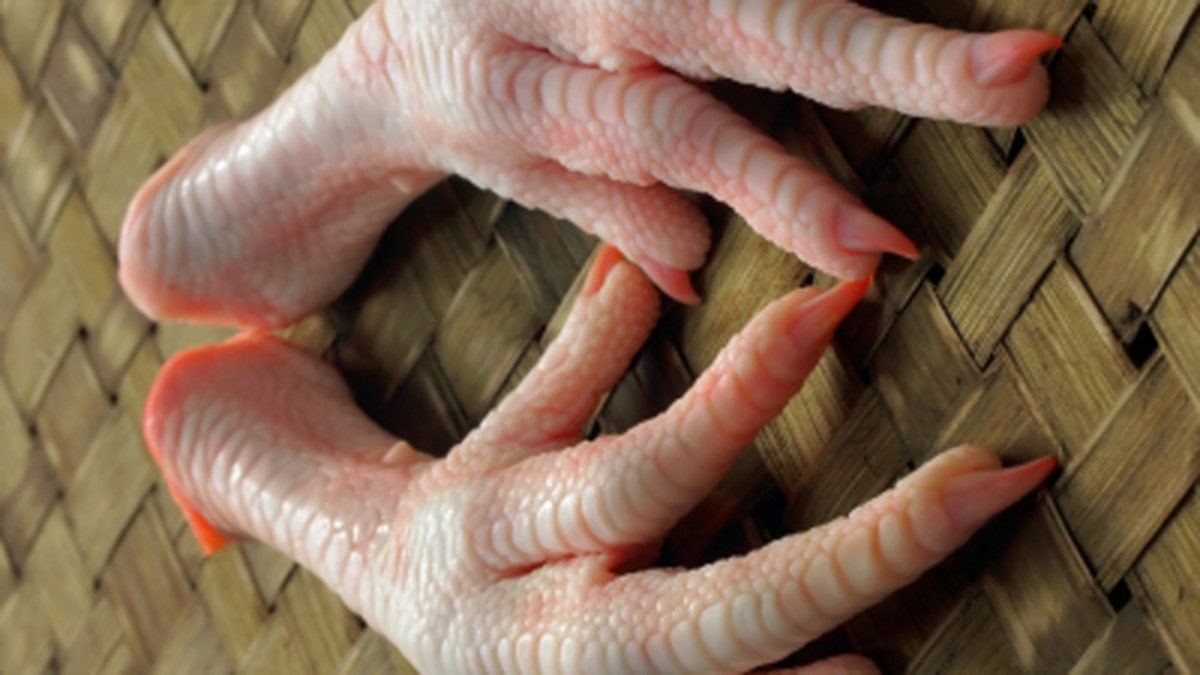
Chicken Feet
Some people satiate their foot fetishes with a pedicure and a pair of five-inch Jimmy Choo platforms. Chris Cosentino handles his by shaving the foot then blowtorching any renegade hairs. Fellow chef and foot-enthusiast James Silk’s solution involves less labor: “There’s not much to do but suck away at them, really. They’re just fun to have a good chew on.”
Cosentino, of San Francisco’s Incanto restaurant is talking pig’s feet and Silk, who overseas the kitchen at Feast in New Orleans, of duck and chicken. Both chefs are masters of offal, those animal parts that you won’t easily find at your local grocer: hearts, brains, tripe, ears and of course, feet. Pig’s feet are rooted in Southern cooking, while braised and deep-fried duck and chicken feet are Asian staples. Duck feet are bonier and have more of that pebbly webbing which at least makes look distinctly avian. Chicken feet, unfortunately, look a lot like a small human hand, minus a finger.
There’s almost nothing to sink your teeth into other than skin, which you chew and discard anyway, so why eat feet? “Because the taste is incredible,” say Cosentino. Braising and deep-frying chicken and duck feet releases and concentrates the flavor in their bones, cartilage, skin and tendons. Getting a good gnaw-on is the only way to tap all that unctuous goodness. “You’re not going to get that flavor any other way,” he says.
Cosentino learned about cooking from his Neapolitan great-grandmother and English grandparents, while Silk was raised on traditional English offal like kidneys, ox hearts and pig’s ears. Both advocate nose-to-tail butchering and consumption and both have a soft spot for feet, particularly pig’s, descriptively known as “trotters.”
When we think “meat” we think skeletal meat, not feet. It’s a generational thing says Cosentino. World War II rationing forced “more offal and less skeletal meats on my mother’s generation and they didn’t like it.” Post-war prosperity meant families no longer had to utilize the whole animal and factory farming made skeletal meats the norm, trends both chefs decry.
That we waste animal parts because we’re squeamish or think we’re above eating them, is something we can get over, says Cosentino. He says we’ve gotten to the point where we only eat food “that has no semblance of having been a living creature, of having had a face.” Most of us do avoid soft, jiggly, gelatinous foods if they’re protein-based. Using every part he says, “gives total and true respect to the animal. We’ve forgotten what food is.”
Incanto’s peasant Italian offal dishes and Feast’s whimsical English ones are here to remind us. Their dishes dovetail with a burgeoning interest among regular folk, as well as “foodies,” in where meat is from, how it’s raised, butchered, utilized and prepared. Cosentino goes through about seventy-five to one hundred pounds of trotters per week. Trotters pack a flavorful punch, like duck and chicken feet, but with a lot more meat. It’s rich and savory and unlike other offal it’s not an acquired taste. It’s offal for newbies. If you like pig, you’ll like trotters. The trick is to counterbalance the meat’s oily intensity with creative cooking that plays up its underlying flavor.
For Trotter Ravioli Cosentino shaves and blowtorches the feet, marinates them for two days in aromatics, vegetables, salt, pepper and wine, then braises until the skin falls offs. He reserves the stock, straining it multiple times. He strips off tendons and meat and seasons with salt, pepper, lemon and orange zest, aleppo chile, parsley and chives, and encases it in pasta.
Foie Gras with Pig’s Feet and Citron Marmalade begins the same way except Cosentino reduces the braising liquid until it’s thick and dense and adds the meat back in. He slathers homemade citron marmalade on toast, tops it with a slice of seared foie gras, chives, salt and pepper. He douses it with trotter meat and stock, its richness cut with sherry vinegar, topping it with peppercress. Trotter Cakes with Red Wine-Braised Snails and Watercress are porcine versions of crab cakes.
New Orleans is the land of the roux, cooked butter and flour that thickens and flavors sauces, but Silk eschews roux. “I thicken many sauces with feet. I always have a bunch in the freezer. It lets me say my dishes are gluten-free,” he says archly. That’s because collagen from bones, cartilage and skin is a natural thickener. He does a duck which involves boning out the neck, filling it with sausage and presenting the bird whole. He serves its feet on side as a kind of macabre garnish. He’s had only limited success with cow’s feet, “they’re very hoofy, not much flesh or cartilage. I’ve tried, I’ve played, but end up using them largely for stock.” He loves trotters and he likes them big enough to stuff.
Silks starts his Chicken Mousse Stuffed Trotters by soaking them raw for twenty-four hours, using a boning knife length-wise along the “wrist” to hollow out the foot. He leaves on the outside toes just for fun. He braises the trotter in stock then stuffs it with chicken mousse flavored with tarragon, shallots and sherry vinegar. He wraps it in foil, squishes it back to its original shape, and poaches it in wine and stock. Pig’s Feet and Bacon is like trotter headcheese. He cooks down trotters, chops up the meat with vegetables and bacon, and serves it with toast and parsley and red onion salad.
The best thing about using pig’s, ears, tails and snouts feet is that they gives chefs like Cosentino and Silk the chance to work with something that’s not just meat, something between flesh, skin and bone, whose structures and substances yield tremendous flavor and silky textures when skillfully handled. Silk shrugs off those who are repelled by his cookery. “We’ve got a big pig on the sign outside,” he says. “What did they think they were coming here for?”
